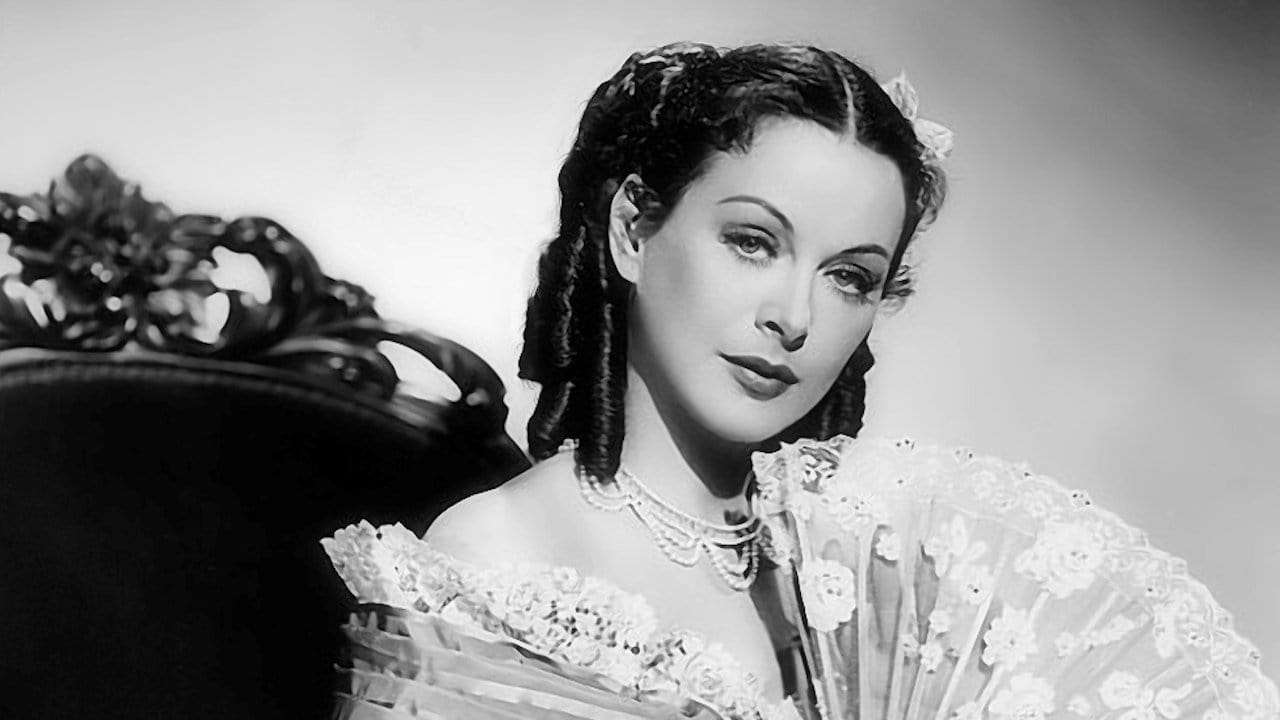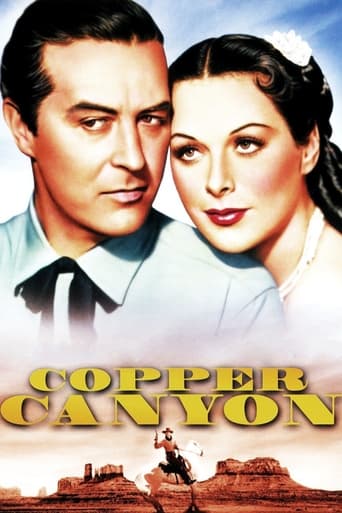

Really Surprised!
... View MoreWhen a movie has you begging for it to end not even half way through it's pure crap. We've all seen this movie and this characters millions of times, nothing new in it. Don't waste your time.
... View MoreI think this is a new genre that they're all sort of working their way through it and haven't got all the kinks worked out yet but it's a genre that works for me.
... View MoreTrue to its essence, the characters remain on the same line and manage to entertain the viewer, each highlighting their own distinctive qualities or touches.
... View MoreAfter they dropped old Hopalong, Paramount seems to have given up on B Western series,s although they kept Pop Sherman employed until 1948. However, like the other majors, they dabbled in the occasional A Western, and COPPER CANYON is an inexplicably tired example. Ray Milland is an ex-Confederate officer (like all actors with Mid-Atlantic accents), making his way as a sideshow trick shooter, called upon to safeguard a town trying to get a copper mine up and running profitably. With Hedy Lamarr, MacDonald Carey, Harry Carey Jr. under the direction of John Farrow, there's nothing wrong, but it all seems like a gimmicky version of one of the Boetticher-Scott westerns of the coming decade. I had the feeling that everyone was trying too hard to be nonchalant, and Charles Lang's rather garish Technicolor camerawork -- although that may be a matter of poor choices in printing -- doesn't help.
... View MoreOriginally, Farrow and Latimer were to continue their association with Ray Milland in Jack of Diamonds. Latimer had already written the screenplay (based on a story by Berne Giler), a contemporary thriller casting Milland as a thief who steals from the Manhattan gem center, when the actor was called to MGM for A Life of Her Own. Paramount lost interest in the project and when Milland returned, it was decided to showcase him in a western instead. The idea of making him a trick-shooter was doubtless inspired by Milland's real-life ability, but unfortunately the script shows many signs of being prepared in considerable haste. "Copper Canyon", Milland's last film with Farrow, is also his least interesting. Yet oddly it was the movie that Universal chose to showcase in their first Farow-Milland DVD release, instead of Farrow's masterpiece, The Big Clock - a movie that figures on everyone's list of the top noir motion pictures ever made! On the other hand, the leading characters in "Copper Canyon" are little more than stock figures - particularly heroine and villain - and some supporting lights are so shadowy, they barely exist at all (Mona Freeman). Other characters and situations are introduced and then not developed. What is worse is that there is very little tension. Not only does the plot have a foregone conclusion, but the characters are so superficially drawn they seem to have no real feeling - and engage no sympathetic response from the audience.Fortunately, the film is not all stock characters in stock situations. There are pleasing incidentals. Milland's trick-shooting gives the hero an interesting edge and his umbrella of a second-rate theatrical company makes for some amusing saloon-pieces which director Farrow handles with obvious relish. The action material too is vigorously staged (including one unforgettable stunt at the climax). But despite some characteristic long takes, dramatic compositions, arresting high angle shots and even a bit of fluid camerawork, you can sense that Farrow's heart is not really involved in the superficial plot. Milland acts with his usual poise, Lamarr is coldly efficient and Carey is okay as a scruffy villain. The support players do their utmost to take advantage of their limited opportunities, but only Erno Verebes ("I'm the professor!") and Maxine Gates as an overweight chorus girl are really allowed to shine. Photographed in pleasantly-hued color on some rugged locations, Copper Canyon is a quite passable western on its own account - but a disappointing end to the Farrow-Milland-Latimer collaboration which produced such masterpieces as The Big Clock and Alias Nick Beal.
... View MoreCopper Canyon is directed by John Farrow and written by John Latimer. It stars Ray Milland, Hedy Lamarr, Macdonald Carey, Mona Freeman and Harry Carey Junior. Music is by Daniele Amfitheatrof and cinematography by Charles Lang.In the bitter period after the Civil War a band of Confederate veterans hoped to start life anew in the rich copper country of the West. They were prepared for the hardships of nature - but not for the greed of men.Much of this production is beautiful and handsome, tech credits are high end, the Technicolor sizzling, costuming sharp, the locations (Vasquez Rocks/Red Rock Crossing/Cathedral Rock et al) a joy for the eyes. Then of course there's the stars, Milland with his elegant looks, Lamarr cute as a button with blood red lips, and Freeman, a classic beauty if ever there was one. So it's with a touch of sadness to report that prettiness is what you ultimately remember most about the pic.Story relies of a filmic Civil War trait that has Yankees and Rebs still feuding post the war, on this occasion the Union people are trying to drive out the Confederates who are trying to make hay (copper) while the sun shines on copper canyon. Enter Milland, who is thought to be an ex Confederate leader now plying his trade as a magician/entertainer/marksman etc. Denying he is the ex soldier in question, he nonetheless gets well and truly involved in things, including courting Lamarr, who may or may not be the axis of the pain brought down on the Confederate miners.The mystery angle involving the principals remains intriguing for the most part, and as old hat as it is, the good guy bad guy shenanigans (Mac Carey of course on chief villain duties) is fun viewing. There's splashes of action, with shootings and chases, the best of the latter unfurling through magnificent scenery, while the big battle at film's end is action packed - even if it is sadly a false dawn since the big face off is a damp squib. But in spite of the beauty and the highlights it still remains a nothing piece, a bit of dressage over substance.It really should have been something more, something other than a pretty play kinda going through the motions. Frustrating. 6/10
... View MoreCopper Canyon is a well turned out, but unremarkable Western -- on the whole not more than a cut above one of Randolph Scott's average numbers. Yet it is unusually pleasurable to look at because of its gorgeous old Technicolor cinematography, exceptionally good use of gorgeous Arizona scenery by top cinematographer Charles Lang, lush sets by Sam Comer and Ross Dowd, stalwartly staged action sequences by director John Farrow, and two of the most gorgeous ladies ever to grace the silver screen -- Hedy Lamarr and Mona Freeman. What more could you ask from a little 60-year old western!Why do I say "old Technicolor"? I and other aficionados are always going on about the beautiful, luminous black & white movies of the late 'thirties, 'forties, and early 'fifties, when the crystal-clear nitrate film was in use. I don't know what kind of film they used for the three-strip Technicolor pictures then, but it seems to me that the color movies of the same period have a sharper, brighter, yet more subtle look than later ones. The color quality of Gone With the Wind (1939), The Private Lives of Elizabeth and Essex (1939), Canyon Passage (1946), and even the little movie were are discussing would never be surpassed in future eras, except perhaps by some of the Vista-Vision movies such as The Searchers (1956). (*see "Addendum" below)Such sumptuous color seemed designed to bring out the staggering beauty of Copper Canyon's two female stars. Neither Hedy Lamarr nor Mona Freeman ever came close to winning a best actress Academy Award, but if the Accademy gave a Gorgeous Dame award, both would have been in the running. Never mind that Hedy was in her late thirties at the time. Those of us who are veteran devotees of beautiful women know that is in fact the age at which women are at their absolute best. And Hedy was living proof in Copper Canyon. She never looked more sultry and desirable. Mona Freeman, age about 24 in 1950, was as pretty and sweet looking a young woman as could possibly be found -- an angelic face with cupid-bow lips framed by golden locks borrowed from a Wateau painting. One of my picky, old wife's movie pet peeves is women in western and other historical settings accoutered with that blaring Tangee lipstick -- you know, the kind that shouts at you. But it sure looked good on the two gorgeous babes of Copper Canyon.Oh, yes, Ray Milland was in the movie, too, as the reluctant hero. Macdonald Carey, usually a good guy but a virile and menacing villain here, nearly steals the show from the top-billed stars. Ray's suave, cool approach is always interesting, but he didn't seem to have his usual sharp edge in this one. Perhaps he was too busy admiring the scenery. Never mind, he and the other stars get lots of support from a pack of fine character actors, the most memorable of whom is the bizarrely colorful Percy Helton as a character named "Scamper".Copper Canyon is a solidly entertaining western and a visual treat.*Addendum: Never wonder about what you can look up. Since posting the above remarks, I have read the Wikipedia article on Technicolor. It was so stultifyingly technical, it would take a physicist (as the inventor of Technicolor was) or a professional photographer, or someone who was both to really understand it. I managed to wade through it armed only with my long ago liberal arts education, and here are the basics as best I can dope it out. The old 3-strip Technicolor process made such beautiful color because the special camera split the incoming light into the three primary colors registered on 3 film strips. These eventually, and magically to those of us technologically challenged, transformed to a single print on which the colors were actually dyed into he surface of the film rather than just printed on it. Result: clear, true, permanent color. The reason the color films from the late 1930's through early 1950's look so much better than most later ones is that they were true Technicolor and the later ones are not. In the late 1950's the studios went over to the cheaper and more convenient but inferior quality and less permanent Eastman Color system. Even later films called Technicolor were just Eastman Color developed at the Technicolor Corporation labs. Exceptions were the movies filmed in Vista Vision and Todd-AO or some other 70 mm wide screen processes. Those were true 3-strip Techicolor. Hope this has been helpful to others who have wondered about this.
... View More